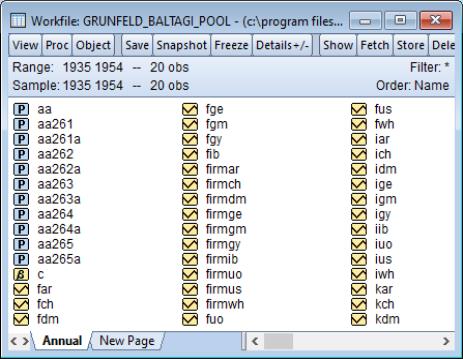The Pool Workfile
The first step in working with pooled data is to set up a pool workfile. There are several characteristics of an EViews workfile that allow it to be used with pooled time series, cross-section data.
First, a pool workfile is an ordinary EViews workfile structured to match the time series dimension of your data. The range of your workfile should represent the earliest and latest dates or observations you wish to consider for any of the cross-section units. For example, if you want to work with data for some firms from 1932 to 1954, and data for other firms from 1930 to 1950, you should create a workfile ranging from 1930 to 1954.
Second, the pool workfile should contain EViews series that follow a user-defined naming convention. For each cross-section specific variable, you should have a separate series corresponding to each cross-section/variable combination. For example, if you have time series data for an economic variable like investment that differs for each of 10 firms, you should have 10 separate investment series in the workfile with names that follow the user-defined convention.
Lastly, and most importantly, a pool workfile must contain one or more pool objects, each of which contains a (possibly different) description of the pooled structure of your workfile in the form of rules specifying the user-defined naming convention for your series.
There are various approaches that you may use to set up your pool workfile:
• First, you may simply create a new workfile in the usual manner, by describing, the time series structure of your data. Once you have a workfile with the desired structure, you may define a pool object, and use this object as a tool in creating the series of interest and importing data into the series.
• Second, you may create an EViews workfile containing your data in stacked form. Once you have your stacked data, you may use the built-in workfile reshaping tools to create a workfile containing the desired structure and series.
Both of these procedures require a bit more background on the nature of the pool object, and the way that your pooled data are held in the workfile. We begin with a brief description of the basic components of the pool object (
“The Pool Object”), and then return to a description of the task of setting up your workfile and data (
“Setting up a Pool Workfile”).

